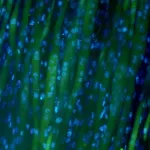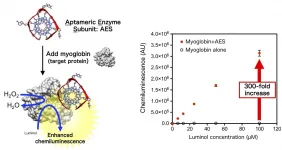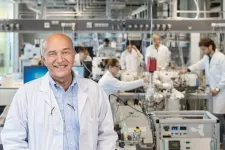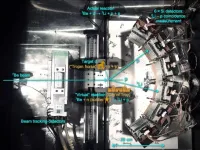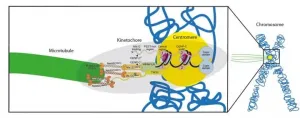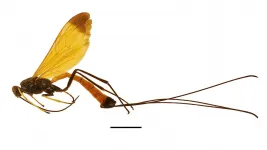Near-death experiences, a survival strategy ?
A study in the journal Brain Communications by Danish and Belgian researchers attributes for the first time a biological purpose to near-death experiences (NDEs)
2021-07-01
(Press-News.org) Near-death experiences are known from all parts of the world, various times and numerous cultural backgrounds. This universality suggests they may have a biological origin and purpose, but exactly what this could be has been largely unexplored.
A new study conducted jointly by the University of Copenhagen (Denmark) and the University of Liege (Belgium) and published in Brain Communications shows how near-death experiences in humans may have arisen from evolutionary mechanisms.
"Adhering to a preregistered protocol, we investigated the hypothesis that thanatosis is the evolutionary origin of near-death experiences", says Daniel Kondziella, a neurologist from Rigshospitalet, Copenhagen University Hospital.
When attacked by a predator, as a last resort defense mechanism, animals can feign death to improve their chances of survival, one example being the opossum. This phenomenon is termed thanatosis, also known as death-feigning or tonic immobility. "As a survival strategy," Daniel Kondziella adds, "thanatosis is probably as old as the fight-or-flight response."
Charlotte Martial, neuropsychologist from the Coma Science Group at ULiège explains: "We first show that thanatosis is a highly preserved survival strategy occurring at all major nodes in a cladogram ranging from insects to fish, reptiles, birds and mammals, including humans. We then show that humans under attack by big animals such as lions or grizzly bears, human predators such as sexual offenders, and 'modern' predators such as cars in traffic accidents can experience both thanatosis and near-death experiences. Furthermore, we show that the phenomenology and the effects of thanatosis and near-death experiences overlap."
Steven Laureys, neurologist and head of GIGA Consciousness research unit and Centre du Cerveau (ULiège, CHU Liège) is excited: "In this paper, we build a line of evidence suggesting that thanatosis is the evolutionary foundation of near-death experiences and that their shared biological purpose is the benefit of survival."
The authors propose that the acquisition of language enabled humans to transform these events from relatively stereotyped death-feigning under predatory attacks into the rich perceptions that form near-death experiences and extend to non-predatory situations.
"Of note, the proposed cerebral mechanisms behind death-feigning are not unlike those that have been suggested to induce near-death experiences, including intrusion of rapid eye movement sleep into wakefulness," Daniel Kondziella explains. "This further strengthens the idea that evolutionary mechanisms are an important piece of information needed to develop a complete biological framework for near-death experiences."
No previous work has tried to provide such a phylogenetic basis. Steven Laureys concludes, "this may also be the first time we can assign a biological purpose to near-death experiences, which would be the benefit of survival."
And Daniel Kondziella adds, "after all, near-death experiences are by definition events that are always survived, without exception."
INFORMATION:
ELSE PRESS RELEASES FROM THIS DATE:
2021-07-01
An affordable lab system that uses grass blades to turn cells into cultured meat has been developed at the University of Bath in the UK.
Researchers have successfully taken grass from the university's campus and used it to create a scaffold that animal cells can attach to and grow on. The resulting tissue has the potential to be used both as lab-made meat and as human muscle tissue to repair or replace tissue which has been damaged or lost through injury or disease.
The study, by Dr Paul De Bank (Department of Pharmacy & Pharmacology), Professor Marianne Ellis (Department of Chemical Engineering) and Scott Allan (a PhD researcher in the Department of Chemical Engineering), is published in this month's Journal of ...
2021-07-01
RUDN University chemists have proposed a new method of producing fuel from Jatropha Curcas, a poisonous tropical plant. Natural minerals and a non-toxic additive from vegetable raw materials are used for that. The reaction efficiency is 85%. The fuel can be used in diesel internal combustion engines. The results are published in the International Journal of Green Energy.
Jatropha Curcas is a common plant in many tropical regions. Its seeds contain lots of oil, but they cannot be used agriculture because the oil contains toxins that are dangerous for people and animals. But the composition of jatropha oil is suitable for the manufacture of biodiesel. One of challenge of the processing the plant raw materials is to select sufficiently ...
2021-07-01
PROVIDENCE, R.I. [Brown University] -- Researchers from Brown University and MIT have developed a new data science framework that allows users to process data with the programming language Python -- without paying the "performance tax" normally associated with a user-friendly language.
The new framework, called Tuplex, is able to process data queries written in Python up to 90 times faster than industry-standard data systems like Apache Spark or Dask. The research team unveiled the system in research presented at SIGMOD 2021, a premier data processing conference, and have made the software freely available to all.
"Python is the primary programming language used by people doing data science," said Malte Schwarzkopf, an assistant professor of computer ...
2021-07-01
A collaboration led by Distinguished Professor Dr. Kazunori Ikebukuro from Tokyo University of Agriculture and Technology (TUAT), Japan, discovered that G-quadruplex (G4)-forming DNA binds myoglobin through a parallel-type G4 structure. Through the G4 binding, the enzymatic activity of myoglobin increases over 300-fold compared to that of myoglobin alone (Figure). This finding indicates that DNA may work as a carrier of genetic information in living organisms and act as a regulator of unknown biological phenomena.
"Aptamers" are nucleic acid-based synthetic ligands that can be used against many target molecules with high affinity and specificity. Some aptamers that bind to proteins ...
2021-07-01
Zeolites are extremely porous materials: Ten grams can have an internal surface area the size of a soccer field. Their cavities make them useful in catalyzing chemical reactions and thus saving energy. An international research team has now made new findings regarding the role of water molecules in these processes. One important application is the conversion of biomass into biofuel.
Fuel made from biomass is considered to be climate-neutral, although energy is still needed to produce it: The desired chemical reactions require high levels of temperature and pressure.
"If ...
2021-07-01
WASHINGTON -- If you've ever tried to capture a sunset with your smartphone, you know that the colors don't always match what you see in real life. Researchers are coming closer to solving this problem with a new set of algorithms that make it possible to record and display color in digital images in a much more realistic fashion.
"When we see a beautiful scene, we want to record it and share it with others," said Min Qiu, leader of the Laboratory of Photonics and Instrumentation for Nano Technology (PAINT) at Westlake University in China. "But we don't want to see a digital photo or video with the wrong colors. Our new algorithms can help digital camera and electronic display developers better adapt their ...
2021-07-01
There is a significant discrepancy between theoretical and observed amounts of lithium in our universe. This is known as the cosmological lithium problem, and it has plagued cosmologists for decades. Now, researchers have reduced this discrepancy by around 10%, thanks to a new experiment on the nuclear processes responsible for the creation of lithium. This research could point the way to a more complete understanding of the early universe.
There is a famous saying that, "In theory, theory and practice are the same. In practice, they are not." This holds true in every academic domain, but it's especially common in cosmology, the study of the entire ...
2021-07-01
A wonder of nature
As a human cell begins division, its 23 chromosomes duplicate into identical copies that remain joined at a region called the centromere. Here lies the kinetochore, a complicated assembly of proteins that binds to thread-like structures, the microtubules. As mitosis progresses, the kinetochore gives green light to the microtubules to tear the DNA copies apart, towards the new forming cells. "The kinetochore is a beautiful, flawless machine: You almost never lose a chromosome in a normal cell!", says Musacchio. "We already know the proteins that constitute it, yet important questions about how the kinetochore works are still open: How does it rebuild itself during chromosome replication? ...
2021-07-01
Researchers at the Biodiversity Unit of the University of Turku, Finland, study insect biodiversity particularly in Amazonia and Africa. In their studies, they have discovered hundreds of species previously unknown to science. Many of them are exciting in their size, appearance, or living habits.
"The species we have discovered show what magnificent surprises the Earth's rainforests can contain. The newly discovered Dolichomitus meii wasp is particularly interesting for its large size and unique colouring. With a quick glance, its body looks black but glitters electric blue in light. Moreover, its wings are golden yellow. Therefore, you could say it's like a flying jewel," says Postdoctoral Researcher Diego Pádua from the Instituto Nacional ...
2021-07-01
Contrary to what science once suggested, older people with a declining sense of smell do not have comprehensively dampened olfactory ability for odors in general - it simply depends upon the type of odor. Researchers at the University of Copenhagen reached this conclusion after examining a large group of older Danes' and their intensity perception of common food odours.
That grandpa and grandma aren't as good at smelling as they once were, is something that many can relate to. And, it has also been scientifically demonstrated. One's sense of smell gradually begins to decline from about the age of 55. Until now, it was believed that one's sense of smell broadly ...
LAST 30 PRESS RELEASES:
[Press-News.org] Near-death experiences, a survival strategy ?
A study in the journal Brain Communications by Danish and Belgian researchers attributes for the first time a biological purpose to near-death experiences (NDEs)
